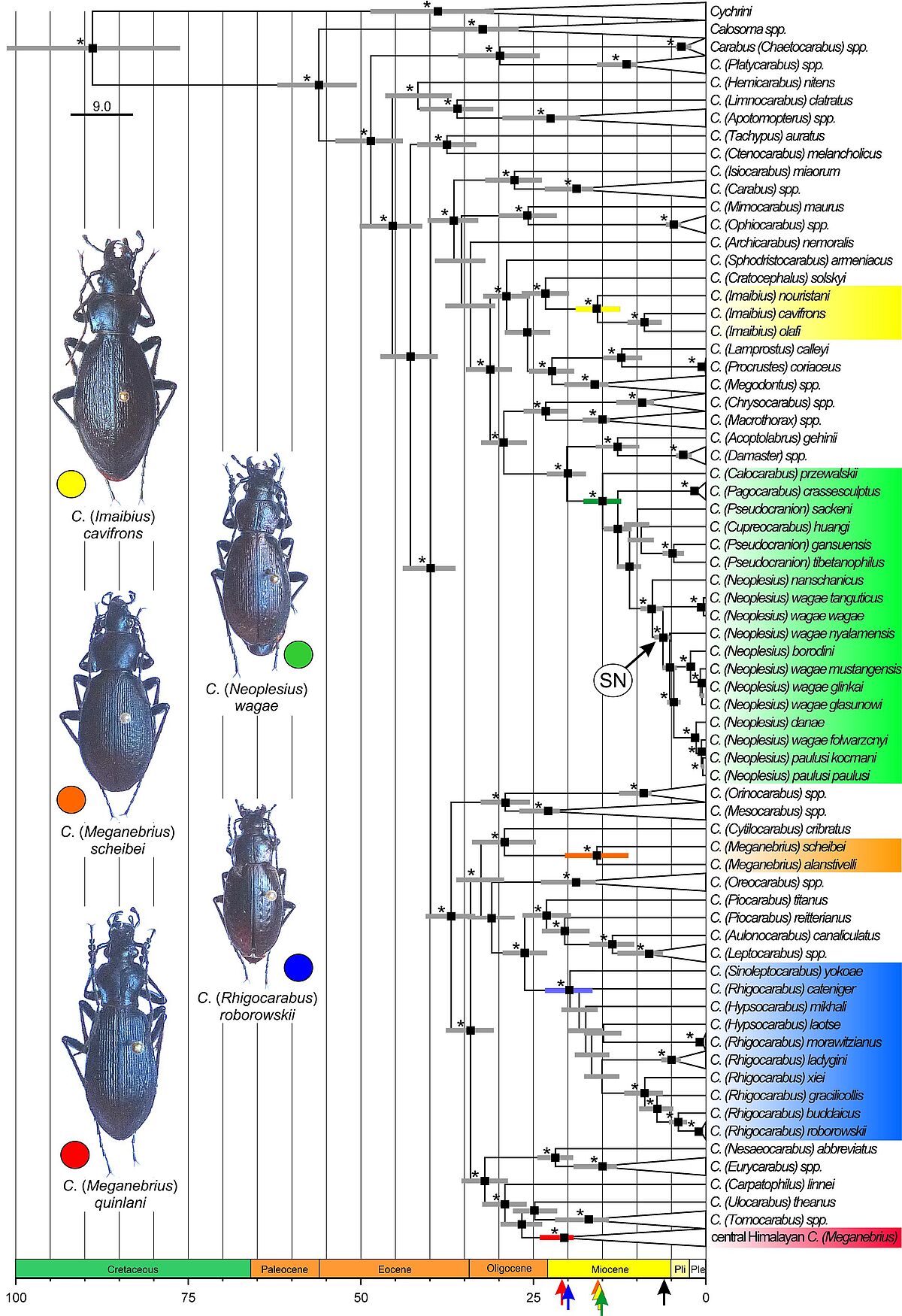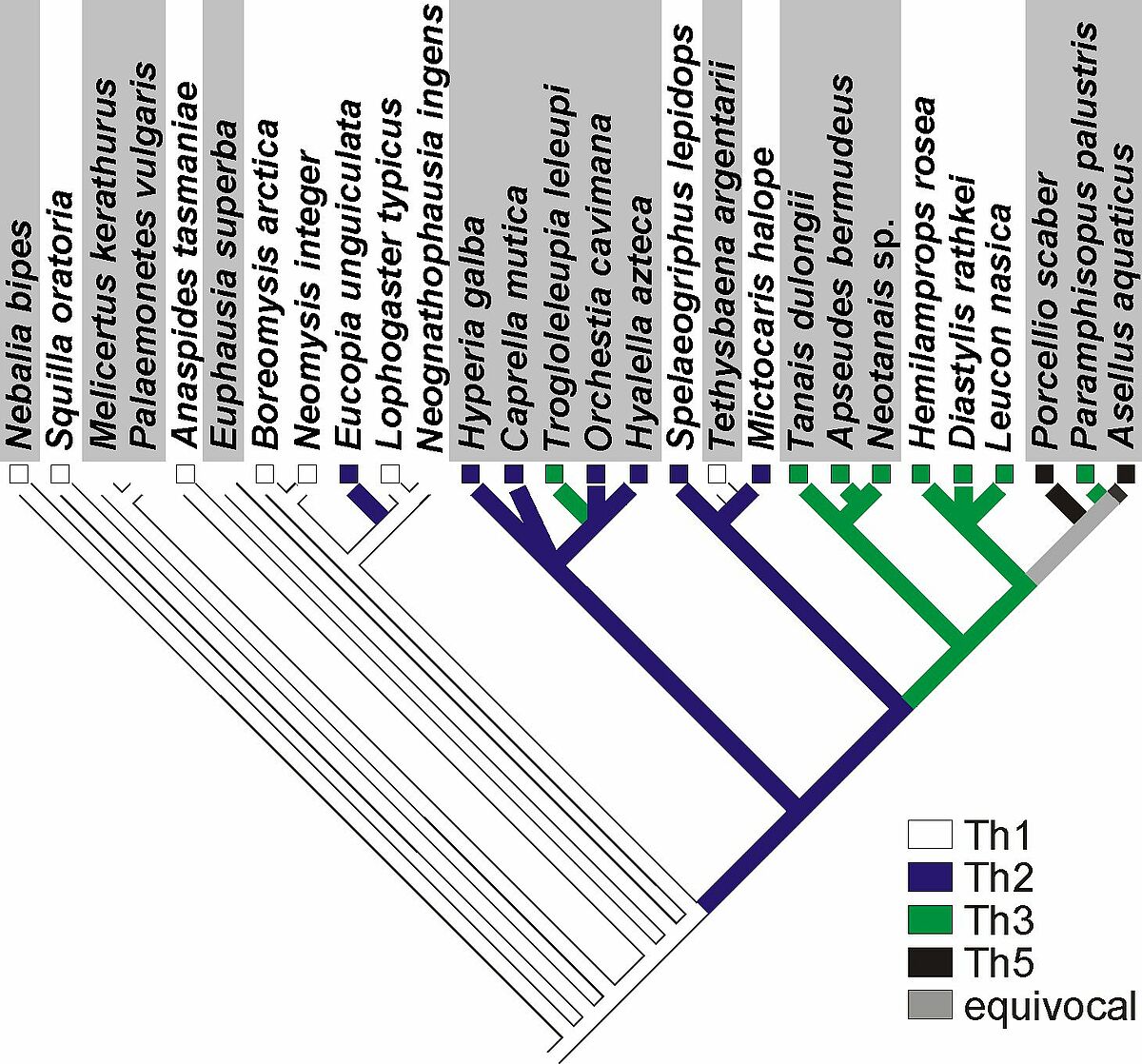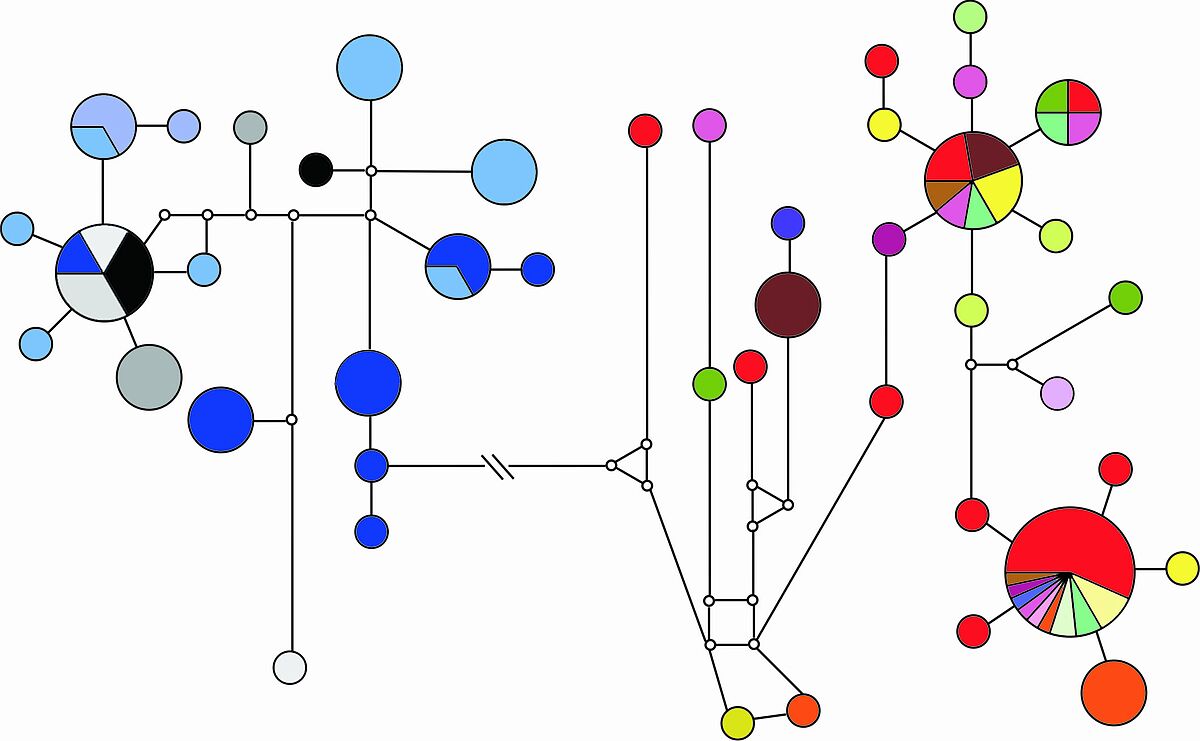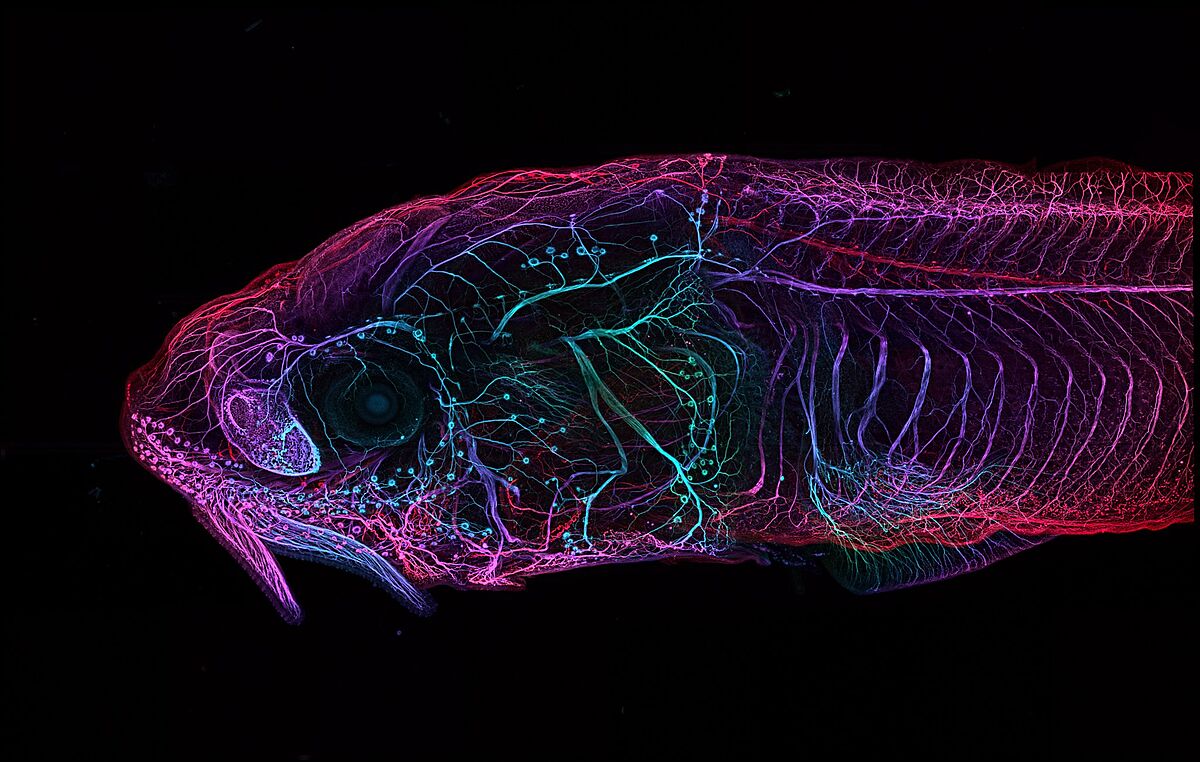Research
Our research covers a wide range of aspects of organism-oriented zoology. We are particularly interested in evolutionary biological issues, especially the emergence of biological disparity and diversity. In addition to investigating the causes of diversity and disparity, we also examine the current mechanisms and conditions that are responsible for changes or enable stability. We use a variety of morphological methods in combination with molecular techniques. The research focuses on invertebrates such as Arthropoda and Annelida, as well as vertebrates such as fish and amphibians.
Evolutionary Morphology
The central questions of evolutionary biology deal with the origin of the diversity of species (biodiversity) and the multiformity of organisms (biodiversity). Just like diversity, disparity is also a result of evolution. Evolutionary morphology describes and interprets the disparity of organisms, using both classical and modern, innovative methods of morphology. Based on phylogenetic analyses, which provide us with information about the phylogenetic relationships of organisms, we try to understand the evolution of organ systems and morphological characters. The changes in individual characters (character transformations) are always considered in the context of the organism as a whole. Ultimately, it is also about understanding the causal mechanisms that have led to changes in the course of evolution. Evolutionary morphology is therefore not only a descriptive but also an explanatory discipline.
Our research centres on the Arthropoda, not only the most species-rich taxon within the animal kingdom, but probably also the most diverse.
We are currently focussing on the evolution of exoskeletal functional units (locomotory and skeletal apparatus) and the associated musculature. We are also studying the evolution of the circulatory system, the nervous system and the sensory organs. Investigations are carried out with the aid of histological section series, micro-computed tomography (µCT) and confocal laser scanning microscopy (cLSM), as well as digital 3D reconstruction based on these methods. Electron microscopy and immunohistochemical staining are also established methods of our working group.
Rillich, B.; Wirkner, C.S. (2025): 3D is not just a tool - a study of the anal capsule in Craterostigmus tasmanianus Pocock, 1902 (Chilopoda, Arthropoda). Arthropod Structure & Development 87, 101450. https://doi.org/10.1016/j.asd.2025.101450
Brandt, J.; Reip, H.S.; Naumann, B. (2024). In flagranti—functional morphology of copulatory organs of odontopygid millipedes (Diplopoda: Juliformia: Spirostreptida). Zoological Journal of the Linnean Society: zlae017. https://doi.org/10.1093/zoolinnean/zlae017
Oliveira, F.G.L.; Smith, A.A. (2024). A morphofunctional study of the jumping apparatus in globular springtails. Arthropod Structure & Development 79: 101333. doi.org/10.1016/j.asd.2024.101333
Rillich, B.; Oliveira, F.G.L. (2023): On latches in biological systems: a comparative morphological and functional study of the retinaculum and the dens lock in Collembola. Frontiers in Zoology 20: 16. https://doi.org/10.1186/s12983-023-00491-2
Jahn, H.; Göpel, T.; Hammel, J.U.; Wirkner, C.S.; Mayer, G. (2023): A multiscale approach reveals elaborate circulatory system and intermittent heartbeat in velvet worms (Onychophora). Communications Biology 6: 468. https://doi.org/10.1038/s42003-023-04797-z
Grams, M.; Klinger, M.; Richter, S. (2023): Neither leg nor jaw—nor always the same: a critical revision of the eumalacostracan maxilliped. Zoological Journal of the Linnean Society 197: 965-1004. https://doi.org/10.1093/zoolinnean/zlac083
Hazerli, D.; Höpel, C. G.; Richter, S. (2022): New insights into the evolution of portunoid swimming crabs (Portunoidea, Heterotremata, Brachyura) and the brachyuran axial skeleton. Frontiers in Zoology 19: 24. https://doi.org/10.1186/s12983-022-00467-8.
Oliveira, F.G.L. (2022): On springtails (Hexapoda: Collembola): a morphofunctional study of the jumping apparatus. Frontiers in Zoology 19: 21. https://doi.org/10.1186/s12983-022-00463-y
Michalski, H.; Harms, D.; Runge, J.; Wirkner, C.S. (2022): Evolutionary morphology of coxal musculature in Pseudoscorpiones (Arachnida). Arthropod Structure & Development 69: 101165. https://doi.org/10.1016/j.asd.2022.101165
Günther, A.; Drack, M.; Monod, L.; Wirkner, C.S. (2021): A unique yet technically simple type of joint allows for the high mobility of scorpion tails. Journal of the Royal Society Interface 18: 20210388. https://doi.org/10.1098/rsif.2021.0388
Scholz, S.; Göpel, T.; Richter, S.; Wirkner, C.S. (2021): High degree of non-genetic phenotypic variation in the vascular system of crayfish – a discussion of possible causes and implications. Zoomorphology 140: 317-329. https://doi.org/10.1007/s00435-021-00536-2
Grams, M.; Richter, S. (2021): Locomotion in Anaspides (Anaspidacea, Malacostraca) – insights from a morpho-functional study of thoracopods with some observations on swimming and walking. Zoology, Article 125883. https://doi.org/10.1016/j.zool.2020.125883.
Hazerli, D.; Richter, S. (2020): Why “swimming crabs” are able to swim - The importance of the axial skeleton: A comparison between the “swimming crab” Liocarcinus depurator and two other brachyuran crabs (Cancer pagurus, Carcinus maenas) using mCT and 3D-reconstruction. Arthropod Structure & Development 59: 100972. https://doi.org/10.1016/j.asd.2020.100972
Schmidt, M.; Hazerli, D.; Richter, S. (2020): Kinematics and morphology: A comparison of 3D-patterns in the fifth pereiopod of swimming and non-swimming crab species (Malacostraca, Decapoda, Brachyura). Journal of Morphology 281: 1547-1566. https://doi.org/10.1002/jmor.21268.
Runge, J.; Wirkner, C.S. (2020): Evolutionary and functional substitution of extrinsic musculature in Solifugae (Arachnida). Journal of Morphology 281: 1524-1533. https://doi.org/10.1002/jmor.21260
Grams, M.; Wirkner, C.S.; Runge, J. (2018): Serial and special: comparison of podomeres and muscles in tactile vs walking legs of whip scorpions (Arachnida, Uropygi). Zoologischer Anzeiger 273: 75-101. https://doi.org/10.1016/j.jcz.2017.06.001
Göpel, T.; Richter, S. (2016): The word is not enough: on morphemes, characters and ontological concepts. Cladistics 32: 682-690. https://doi.org/10.1111/cla.12145
Richter, S.; Wirkner, C.S. (2014): A research program for Evolutionary Morphology. Journal of Zoological Systematics and Evolutionary Research 52: 338-350. https://doi.org/10.1111/jzs.12061
Phylogeny
Phylogenetic systematics attempts to clarify the phylogenetic relationships of species. It uses morphological characters, but increasingly also molecular methods. A central aspect is homology research. Morphological characters are examined in detail and compared with the characters of other species. If there are similarities in structure and position or in development, a common origin of these characters can be inferred. This common origin can usually be explained by a common phylogenetic origin. However, homologous characters only allow direct conclusions to be drawn about relationships if they are derived, apomorphic characters. Ancestral (plesiomorphic) characters cannot be used for reconstruction. For morphological phylogenetic analyses, a large number of character complexes are examined and taken into account. There are a priori no characters that are less or more qualified. In addition to morphological characters, we also analyse various molecular markers. It is important to analyse not just individual genes, but a range of different loci. Molecular and morphological methods complement each other in resolving phylogenetic relationships. Under no circumstances can molecular markers replace analyses of morphological characteristics.
Our research centres on arthropods, especially the Malacostraca ("Crustacea"). Ongoing investigations are focussing in particular on the phylogeny of the Peracarida, which include Isopoda (e.g. woodlice) and Amphipoda (e.g. sandhoppers). In addition to practically performing phylogenetic analyses, we also work on theoretical aspects of the methodology of computerized cladistics. This includes, for example, the handling of ontological character dependencies and the search for objective methods to balance the typical imbalance of morphological and molecular data in order to carry out combined ‘total evidence’ analyses.
Grams, M.; Torres, A.; Wirkner, C.S.; Richter, S. (2025): A new morphological phylogeny of Malacostraca comparing the application of character dependencies and implied weighting. Cladistics 41(3). https://doi.org/10.1111/cla.12611
Pflug, J.M.; Schmidt, J.; Sproul, J.S.; Weng, Y.-M.; Maruyama, M.; Henrichs, B.; Everson, K.M.; Maddison, D.R. (2024): Phylogenomics of the major lineages of Bembidion and related ground beetles (Coleoptera: Carabidae: Bembidiini). Insect Systematics and Diversity, 8(5), 9; 2024, ixae025. https://doi.org/10.1093/isd/ixae025
Grams, M.; Richter, S. (2023): On the four complementary aspects of hierarchical character relationships and their bearing on scoring constraints, expressed in a new syntax for character dependencies. Cladistics. 39, 437–455. https://doi.org/10.1111/cla.12550.
Höpel, C. G.; Yeo, D.; Ahyong, S. T.; Meier, R.; Richter, S. (2023): First mitochondrial genomes of Anaspidacea (Malacostraca, Crustacea) and the phylogenetic relationships of mountain shrimps (Anaspides Thomson, 1894) and their relatives within Anaspidesidae. Journal of Crustacean Biology, 43(2). https://doi.org/10.1093/jcbiol/ruad028
Höpel, C.G.; Yeo, D.; Grams, M.; Meier, R.; Richter, S. (2022): Mitogenomics supports the monophyly of Mysidacea and Peracarida (Malacostraca). Zoologica Scripta, 51, 603– 613. https://doi.org/10.1111/zsc.12554
Wirkner, C.S.; Richter, S. (2010): Evolutionary Morphology of the circulatory system in Peracarida. Cladistics: 26: 143-167.
Richter, S.; Scholtz, G. (2001): Phylogenetic analysis of the Malacostraca (Crustacea). Journal of Zoological Systematics and Evolutionary Research 39, 113-136.
Ichthyology
Ichthyology is the branch of zoology that deals with fish and fish-like vertebrates (bony fish, cartilaginous fish and cyclostomes). The Unterwarnow as the only estuary in the southern Baltic Sea as well as the bodden and lagoons in the immediate vicinity (Darss-Zingst Bodden Chain, Bodden of Rügen, Bay of Greifswald, Strelasund and Oder Lagoon) are interesting study areas with regard to their composition of fish species as a mix of primary freshwater and saltwater species. The ichthyocoenoses are dominated by freshwater species that have adapted to the oligo- and mesohaline conditions of these so-called ‘inner coastal waters’ and occur in large biomasses. Due to this abundance of fish, small-scale coastal fisheries are still very active in these waters. In order to ensure ecosystem-based fisheries management, the requirements of fish species for these special habitats must be researched. Consequently, the physiological and ecological adaptations of these species to the salty habitat are an interesting research field. The focus of our research is currently on the spatial and reproductive ecology of pike (Esox lucius) and European perch (Perca fluviatilis). Despite their freshwater origin, adult individuals are able to migrate to the Baltic Sea and its lagoons to feed, but do they reproduce there? We want to answer these questions by means of field studies, hatching experiments, microchemical analyses of otoliths and population genetics, in order to do justice to the importance of this species, on the one hand as predators in the food web, and on the other as important economic factors for both commercial and recreational fishing in the region.
Unger, P., Schmidt, J., Dorow, M., Möller, S., Palm, H. (2024). Reaching the steady state: 30 years of Anguillicola crassus infection of European eel, Anguilla anguilla L., in Northern Germany. Parasitology. 2024:1-29. doi:10.1017/S0031182024000039
Roser P.; Dhellemmes, F.; Rittweg, T.; Möller, S.; Winkler, H.W.; Lukyanova, O.; Niessner, D.; Schütt, J.; Kühn, C.; Dennenmoser, S.; Nolte, A.W.; Radinger, J.; Koemle, D.; Arlinghaus, R. (2023): Synthesizing historic and current evidence for anadromy in a northern pike (Esox lucius L.) meta-population inhabiting brackish lagoons of the southern Baltic Sea, with implications for management. Fisheries Research, 263, 106670, https://doi.org/10.1016/j.fishres.2023.106670
Arlinghaus, R.; Rittweg, T.; Dhellemmes, F.; Koemle, D.; van Gemert, R.; Schubert, H.; Niessner, D.; Möller, S.; Droll, J.; Friedland, R.; Lewin, W.-C.; Dorow, M.; Westphal, L.; Ehrlich, E.; Strehlow, H.V.; Weltersbach, M.S.; Roser, P.; Braun, M.; Feldhege, F.; Winkler, H.W. (2023): A synthesis of a coastal northern pike (Esox lucius) fishery and its social-ecological environment in the southern Baltic Sea: Implications for the management of mixed commercial-recreational fisheries. Fisheries Research, 263, 106663, https://doi.org/10.1016/j.fishres.2023.106663
Möller, S.; Winkler, H.M.; Richter, S.; Bastrop, R. (2021): Genetic population structure of pike (Esox lucius Linnaeus, 1758) in the brackish lagoons of the southern Baltic Sea. Ecology of Freshwater Fish 30: 140-149. https://doi.org/10.1111/eff.12571
Möller, S.; Winkler, H.M.; Klügel, A.; Richter, S. (2019): Using otolith microchemical analysis to investigate the importance of brackish bays for pike (Esox lucius Linnaeus, 1758) reproduction in the southern Baltic Sea. Ecology of Freshwater Fish 28: 602-610. https://doi.org/10.1111/eff.12478
Taxonomy & Biodiversity research
How can the fascinating biological diversity be categorised into a comprehensible system that reflects the evolutionary relationships between living organisms and thus creates the foundation of organismic biology as a whole? Taxonomy is concerned with no less than this question. Its task is to identify, name and systematically categorise all living organisms according to internationally established rules. To do this, it is necessary to recognise biological species and higher taxonomic units (genus, family, etc.) and to differentiate these from similar or related units (taxa). This is a challenging endeavour, as hundreds of new species are still being discovered on Earth every year. Exciting excursions to little-studied habitats, the investigative study of collection material in museums and the software-based comparison of DNA sequences are essential for this. Equally essential is an in-depth knowledge of all taxa of the considered group and their characteristics. Here we combine the latest methods of morphology and molecular genetics. With the help of X-ray microscopy, we have not only discovered new ground beetle species in Eocene amber, but have also gained a new perspective on the taxonomy of previously known fossils. During expeditions, new ground beetles were found in Tibet, the Himalayas and the highlands of Ethiopia, and cryptic species of Tasmanian mountain shrimps and other Australian freshwater crustaceans were identified and the history of their distribution reconstructed with the help of new molecular genetic methods such as ddRad sequencing. This research has resulted not only in the discovery and description of numerous new species, but also in a deeper understanding of the evolution of the taxa themselves and their habitats. In addition to these ‘exotic’ research areas, research into regional biodiversity is primarily carried out in coastal habitats of the Baltic Sea. Among other things, the effects of different forms of utilisation and the influence of climate change on insects and spiders are investigated, thus making an integral contribution to local nature conservation.
Taxonomy
Schmidt, J., Merene, Y., Woldehawariat, Y., Faille, A. (2025): Trechus from Ethiopia with aedeagus right side superior in repose, an unusual character state in trechine beetles (Coleoptera: Carabidae). Insects 16: 328. https://doi.org/10.3390/insects16030328
Hofmann, S., Jablonski, D., Schmidt, J. (2024): Morphological and molecular data warrant the description of a new species of the genus Scutiger (Anura, Megophryidae) from the Central Himalaya. ZooKeys 1210: 229–246. https://doi.org 10.3897/zookeys.1210.127106
Schmidt, J., Merene, Y. (2024): Taxonomy, distribution and habitat of the giant Trechus beetles endemic to Mt. Choke, Ethiopia (Coleoptera: Carabidae). Taxonomy 4 (1): 27–50. https://doi.org/10.3390/taxonomy4010003
Schmidt, J., Faille, A. (2024): Two unexpected discoveries in the Nepal Himalaya: the microphthalmic Duvalius himalayicus sp. n. and the anophthalmic Duvalioblemus nepalicola sp. n. (Insecta: Coleoptera: Carabidae: Trechini). In: Hartmann, M., Barclay, M.V.L. & Weipert, J. (eds.): Biodiversity and Natural Heritage of the Himalaya. Vol. VIII. Verein der Freunde und Förderer des Naturkundemuseums Erfurt e.V., Erfurt: 283–291.
Schmidt, J., Scholz, S., Wiesner, J., Will, K. (2023): MicroCT data provide evidence correcting the previous misidentification of an Eocene amber beetle (Coleoptera, Cicindelidae) as an extant species. Scientific Reports 13: 14743. https://doi.org/10.1038/s41598-023-39158-7
Faille, A., Hofmann, S., Merene, Y., Hauth, D., Opgenoorth, L., Woldehawariat, Y., Schmidt, J. (2023): Explosive radiation versus old relicts: The complex history of Ethiopian Trechina, with description of a new genus and a new subgenus (Coleoptera, Carabidae, Trechini). Deutsche Entomolologische Zeitschrift, 70 (2): 311–335. https://doi.org/10.3897/dez.70.107425
Schmidt, J., Opgenoorth, L., Mao, K., Baniya, C.B., Hofmann, S. (2023): Molecular phylogeny of mega-diverse Carabus attests late Miocene evolution of alpine environments in the Himalayan-Tibetan Orogen. Scientific Reports 13: 13272. https://doi.org/10.1038/s41598-023-38999-6
Höpel, C.G., Richter, S., Ahyong, S.T. (2023). A New Species of Tasmanian Mountain Shrimp, Anaspides driesseni sp. nov. (Malacostraca, Anaspidacea, Anaspidesidae). Records of the Australian Museum, 75(1), 25–43. https://doi.org/10.3853/j.2201-4349.75.2023.1829
Schmidt, J., Scholz, S., Will, K. (2022): Character analysis and descriptions of Eocene sphodrine fossils (Coleoptera, Carabidae) using light microscopy, micro-CT scanning, and 3D imaging. Deutsche Entomologische Zeitschrift 69 (1): 19–44. https://doi.org/10.3897/dez.69.79931
Schmidt, J., Scholz, S., Maddison, D.R. (2021): Balticeler kerneggeri gen. nov., sp. nov., an enigmatic Baltic amber fossil of the ground beetle subfamily Trechinae (Coleoptera, Carabidae). Deutsche Entomologische Zeitschrift 68 (1): 207–224. https://doi:10.3897/dez.68.66181
Biodiversity research in Mecklenburg-Vorpommern
Lindner, M.; Kleeberg, A.; Martin, D.; Schmidt, J. (2025): Die Mahd nasser Moorstandorte verringert die Aktivitätsdichte, Aktivitätsbiomasse und Habitateignung für gefährdete Bodenarthropoden. Natur und Landschaft 100 (4): 139–147. https://doi.org/10.19217/NuL2025-04-02
Schmidt, J., Bachmann, O., Ewald, J., Frase, T., Höpel, C.G., Hoffmann, H., Kornmilch, J.-C., Lehmann, J.F., Martin, D., Wilde, M., Winter, J., Naumann, B. (2024): Erfassung von Arthropoden in Nordwestmecklenburg im Rahmen einer Studienexkursion der Universität Rostock – Ergebnisbericht 2024.Archiv Natur- und Landeskunde Mecklenburg-Vorpommern 60: 3–11. https://doi.org/10.30819/anlk.60.04
Ladner, M., Lindner, M., Schmidt, J. (2024): Weniger Beweidung ist mehr Diversität: Ergebnisse einer Erfassung von Wanzen (Insecta: Hemiptera: Heteroptera) in zwei Küstenniederungen nach Deichrückbau und Etablierung unterschiedlicher Weideregime. Archiv Natur- und Landeskunde Mecklenburg-Vorpommern 60: 3–11. https://doi.org/10.30819/anlk.60.03
Bachmann, O., Thiede, M., Schmidt, J. (2024): Kartierung von Nachtfaltern im Naturschutzgebiet „Radelsee“ bei Rostock im Jahr 2023. Archiv Natur- und Landeskunde Mecklenburg-Vorpommern 60: 12–32. https://doi.org/10.30819/anlk.60.02
Schmidt, J., Kleeberg, A., Kornmilch, J.-C., Bachmann, O., Albe, F., Dörnbrack, K., Ehlermann, J., Erber, T.M., Guschker, L.V., Höpel, C.G., Lappe, V., Lembach, L.-K., Morana, M., Riegert, J.W., Ruf, J., Schmitt, F., Schneider, J., Taege, T.J., Thiesen, P., Naumann, B. (2023). Erfassung von Arthropoden an der Lübecker Bucht im Rahmen einer Studienexkursion der Universität Rostock-Ergebnisbericht 2023. Archiv Natur-und Landeskunde Mecklenburg-Vorpommern 59: 65–96. https://doi.org/10.30819/anlk.59.05.
Evolutionary Developmental Biology („Evo-Devo“)
What processes underlie the impressive diversity (biodiversity) and variety (biodisparity) of organisms that lived and still live on planet Earth? Evolutionary developmental biology, or "evo-devo" for short, sheds light on the interface between development and evolution in an attempt to answer precisely this question. It investigates how changes in the developmental processes of organisms can lead to evolutionary changes.
One of the key concepts of evolutionary developmental biology that we investigate in our research group is modularity. The concept of modularity describes the construction of organisms from many quasi-autonomous subunits (cells, tissues, organs, etc.) - so-called modules. These modules can then be changed to varying degrees within a developmental system without disrupting the system as a whole. Evolutionary changes in the time of development (heterochrony), the place of development (heterotopy) or the intensity of development processes (heterometry) in different modules can thus lead to a repatterning of individual development and thus to the emergence of new characters. However, not all of these modules can be changed to the same extent. Some are subject to high genetic, developmental and functional constraints that limit their potential changes and thus the evolutionary possibilities.
The aim of our research group is to uncover such developmental constraints and to clarify their role in the evolution of biodiversity and biodisparity. For a holistic picture and to test the general explanatory power of these concepts, we work not only on Vertebrata but also on unicellular flagellates (Choanoflagellates), comb-jellies (Ctenophora) and Arthropoda. To study the changes in complex morphological features, we use high-resolution imaging techniques such as confocal laser scanning and X-ray microscopy (µCT) in combination with state-of-the-art 3D imaging techniques as well as morphometric methods and anatomical network analyses.
Burkhardt, P., Colgren, J., Medhus, A., Digel, L., Naumann, B., Soto-Angel, J.J., [...], Kittelmann, M. (2023). Syncytial nerve net in a ctenophore adds insights on the evolution of nervous systems. Science, 380(6642), 293-297.
Naumann, B.*, Warth, P.*, Hammel, J. U., Moosmann, J., Konstantinidis, P., Olsson, L. (2023). Development of the branchial musculature of the Siberian sturgeon (Acipenser baerii) reveals a heterochronic shift during the evolution of acipenseriform cranial muscles. bioRxiv, 2023-02. (*shared first authorship)
Levit, G.S., Hoßfeld, U., Naumann, B., Lukas, P., Olsson, L. (2022). The biogenetic law and the Gastraea theory: From Ernst Haeckel's discoveries to contemporary views. Journal of Experimental Zoology Part B: Molecular and Developmental Evolution, 338(1-2), 13-27.
Sachkova, M.Y., Nordmann, E.L., Soto-Àngel, J.J., Meeda, Y., Górski, B., Naumann, B., [...], Burkhardt, P. (2021). Neuropeptide repertoire and 3D anatomy of the ctenophore nervous system. Current Biology, 31(23), 5274-5285
Naumann, B., Schweiger, S., Hammel, J.U., Müller, H. (2021). Parallel evolution of direct development in frogs‐Skin and thyroid gland development in African Squeaker Frogs (Anura: Arthroleptidae: Arthroleptis). Developmental Dynamics, 250(4), 584-600.
Göhde, R.*, Naumann, B.*, Laundon, D., Imig, C., McDonald, K., Cooper, B. H., ... & Burkhardt, P. (2021). Choanoflagellates and the ancestry of neurosecretory vesicles. Philosophical Transactions of the Royal Society B, 376(1821), 20190759. (*shared first authorship)
Naumann, B., Burkhardt, P. (2019). Spatial cell disparity in the colonial choanoflagellate Salpingoeca rosetta. Frontiers in cell and developmental biology, 7, 231.
Naumann, B., Englert, C. (2018). Dispersion/reaggregation in early development of annual killifishes: phylogenetic distribution and evolutionary significance of a unique feature. Developmental biology, 442(1), 69-79.
Warth, P., Hilton, E.J., Naumann, B., Olsson, L., Konstantinidis, P. (2018). Development of the muscles associated with the mandibular and hyoid arches in the Siberian sturgeon, Acipenser baerii (Acipenseriformes: Acipenseridae). Journal of Morphology, 279(2), 163-175.
Naumann, B., Warth, P., Olsson, L., Konstantinidis, P. (2017). The development of the cucullaris muscle and the branchial musculature in the Longnose Gar (Lepisosteus osseus, Lepisosteiformes, Actinopterygii) and its implications for the evolution and development of the head/trunk interface in vertebrates. Evolution & Development, 19(6), 263-276.
Phylogeography



Phylogeography attempts to explain the distribution patterns of species and populations or genetic lineages and to understand the current and historical geographical and ecological causes as well as the underlying phylogenetic principles and processes. It combines biogeography with phylogenetic systematics and population genetics and utilises various molecular genetic and biostatistical methods. Phylogeography can thus contribute to reconstructing past ecological or geological events such as cave or mountain formation, glaciations or climate change. As separation events lead to the separation of populations, reduced gene flow and ultimately to speciation, phylogeography can also be used to reconstruct speciation processes.
Our current phylogeographic studies are focussed on various groups of arthropods, especially beetles (Coleoptera) and crustaceans as well as amphibians. In particular, we deal with Tasmanian mountain shrimps (Anaspides), freshwater isopods (Phreatoicidea) and clam shrimps (Branchiopoda) of Australia, as well as ground beetles (Carabidae) of the Himalayas and the Ethiopian highlands. The Tasmanian mountain shrimps, often referred to as living fossils, inhabit mountain lakes in the remote montane regions of Tasmania as well as a variety of cave systems. The same applies to the freshwater isopods. In both groups we try to reconstruct the immigration into the subterranean habitat, also in connection with the glaciations of Tasmania, as well as the post-glacial colonisation history of the mountain plateaus. Phylogeographic work on various groups of ground beetles and amphibians serves to reconstruct mountain formation and climate genesis in High Asia and East Africa.
Selected Publications
Hofmann, S., Podsiadlowski, L., Andermann, T., Matschiner, M., Baniya, C.B., Martin, S., Masroor, R., Yang, J., Zheng, Y., Jablonski, D., Schmidt, J. (2024): The last of their kind: Is the genus Scutiger (Anura: Megophryidae) a relict element of the paleo-transhimalaya biota? Molecular Phylogenetics and Evolution 201: 108166. https://doi.org/10.1016/j.ympev.2024.108166
Höpel, C.G., Richter, S., Ahyong, S.T. (2023). A new species of Tasmanian Mountain Shrimp, Anaspides driesseni sp. nov. (Malacostraca, Anaspidacea, Anaspidesidae). Records of the Australian Museum, 75(1), 25-43.
Höpel, C.G., Ahyong, S.T., Richter, S. (2021). Genetic structure and new occurrence records of the iconic Tasmanian mountain shrimp Anaspides tasmaniae (Thomson, 1893)(Anaspidesidae: Anaspidacea) reveal relictual distribution in southern Tasmania. Australian Journal of Zoology, 68(1), 45-53.
Richter, S., Schwentner, M., Wirkner, C.S., Ahyong, S.T. (2018). Phylogeny and species diversity of Tasmanian mountain shrimps and their relatives (Crustacea, Anaspidesidae). Zoologica Scripta, 47(1), 84-105.









